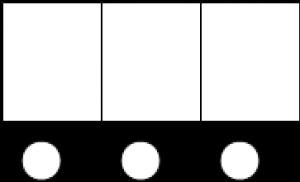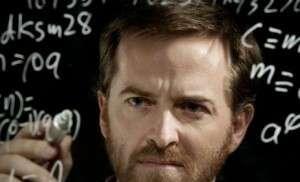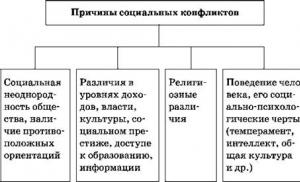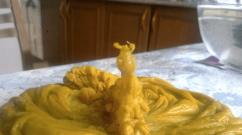The concept of thinking, types, operations and forms of thinking. Thinking The type of thinking in which the thought process
Thinking is a cognitive mental process of generalized and indirect reflection of connections and relationships between objects of objective reality. Thinking is a process associated with the processing of information, either received through sensations, or stored in memory as a result of personal experience, in order to be able to react in a new situation. The following distinguishing features are distinguished:
1. The main function of thinking is to identify internal connections in objects.
2. Thinking relies in its knowledge on these sensory images;
3. Thinking can be divorced from the real world, since for cognition a "substitute" of objects of the external world can be used - a sign, a symbol
4. Thinking proceeds as a whole based on the knowledge acquired earlier;
5. Feature - mental results are initially generalized;
6. We can think not only in terms of the present, but also of the past and the future.
Types of thinking:
1. By the nature of the tasks being solved:
- theoretical - aimed at finding general patterns.
- practical - aimed at solving particular specific problems.
2. By the way of solving problems (by the genesis of development):
- visual-effective (substantively-effective) - the object is the instrument.
Feature - with its help it is impossible to solve the task without the participation of practical actions. That is why he has such a close connection with practice.
- visual-figurative - allows you to learn about the real world without the participation of practical actions, can be carried out only in the ideal plan. Distinctive features: simultaneity (simultaneity), impulsivity and synthetics.
- verbal-logical (conceptual) - using this type of thinking, a person can analyze, compare phenomena, objects, situations, assessing an object, situation, phenomenon, both from his own point of view and from other points of view.
- abstract-logical (abstract) - highlighting the essential properties and connections of an object and abstraction from others, insignificant.
3. By the degree of deployment:
-discursive (logical) - mediated by the logic of reasoning, not perception.
-intuitive - thinking based on direct sensory perceptions and direct reflection of the effects of objects and phenomena of the objective world.
4. according to the degree of novelty and originality:
-creative (productive) - thinking based on creative imagination.
-recreative (reproductive) - thinking on the basis of images and ideas, gleaned from some specific sources.
5. By means of thinking:
- verbal - thinking operating with abstract sign structures.
- visual - thinking based on images and representations of objects.
6. By function:
- critical - aimed at identifying flaws in the judgments of other people
- creative - associated with the discovery of fundamentally new knowledge, with the generation of their own original ideas, and not with the assessment of other people's thoughts.
Basic forms of thinking:
Concept - a form of thinking that reflects the essential properties of objects and phenomena
Judgment is a form of thinking that reflects connections between objects and phenomena
Inference is a form of thinking in which a certain conclusion is made on the basis of judgments.
Thinking operations:
-analysis (mental separation) - the selection in the object of one or another of its sides, elements, properties, connections, relationships, etc .; it is the dismemberment of the cognized object into various components.
-synthesis (mental unification) - a mental operation that allows in a single analytical-synthetic process of thinking to move from parts to the whole.
-generalization (mental unification into a class or category) - the unification of many objects or phenomena according to some common criterion.
-comparison - an operation that consists in comparing objects and phenomena, their properties and relationships with each other and in identifying the commonality or difference between them.
-abstraction (highlighting some features and distinguishing from others) - a mental operation based on abstraction from insignificant features of objects, phenomena and highlighting the main, the main thing in them.
- classification - systematization of subordinate concepts of any area of knowledge or human activity, used to establish links between these concepts or classes of objects.
- categorization - the operation of referring a single object, event, experience to a certain class, which can be verbal and non-verbal meanings, symbols, etc.
Most often, thinking is divided into theoretical and practical. At the same time, in theoretical thinking, conceptual and figurative thinking are distinguished, and in practical thinking - visual-figurative and visual-effective (1).
Theoretical conceptual thinking- this is the kind of thinking, using which a person, in the process of solving a problem, turns to concepts, performs actions in his mind, without directly dealing with the experience obtained with the help of the senses. Theoretical conceptual thinking is characteristic of scientific theoretical research.
Theoretical figurative thinking differs from the conceptual in that the material that a person uses here to solve a problem is not concepts, judgments or inferences, but images. They are either directly retrieved from memory or creatively recreated by the imagination. Such thinking is used by workers in literature, art, in general, people of creative work who deal with images.
Both considered types of thinking - theoretical conceptual and theoretical figurative - in reality, as a rule, coexist. They complement each other well, reveal to a person different, but interrelated aspects of life. Theoretical conceptual thinking gives, although abstract, but at the same time the most accurate, generalized reflection of reality. Theoretical figurative thinking allows you to get a specific subjective perception of it, which is no less real than the objective-conceptual one.
Visual-figurative thinking- this is a type of thought process that is carried out directly in the perception of the surrounding reality and cannot be carried out without it. Thinking in a visual-figurative manner, a person is tied to reality, and the images necessary for thinking themselves are presented in his short-term and operative memory (in contrast to this, images for theoretical figurative thinking are extracted from long-term memory and then transformed). This form of thinking is most fully and fully represented in children of preschool and primary school age, and in adults - among people engaged in practical work. At the same time, they only observe the objects of their activity, without directly touching them.
Visual-Action Thinking- this is a type of thinking, the essence of which lies in the practical transformative activity carried out with real objects. This type of thinking is widely represented among people engaged in industrial labor, the result of which is the creation of any material product.
The listed types of thinking act simultaneously as the levels of its development. Theoretical thinking is considered more perfect than practical, and conceptual thinking is a higher level of development than figurative thinking. The difference between theoretical and practical types of thinking, according to B. M. Teplov, is only that “they are connected in different ways with practice ... The work of practical thinking is mainly aimed at solving particular specific problems ... while the work of theoretical thinking is aimed mainly at finding general patterns ”(2).
All of the listed types of thinking coexist in humans, can be represented in the same activity. However, depending on its nature and ultimate goals, one or another type of thinking dominates. For this reason, they all differ. According to the degree of their complexity, according to the requirements they place on the intellectual and other abilities of a person, all the named types of thinking are not inferior to each other.
1. Nemov RS Psychology. In 3 kn. - M .: VLADOS, 2003. - Book. 1: General Foundations of Psychology. P. 275.
2. Teplov BM Practical thinking // Reader in general psychology: Psychology of thinking. - M .: Publishing house of Moscow State University, 1981.S. 147.
Most of the time the human brain spends on the process of processing information. She enters him through various sensations, thoughts, images and experiences. These conditions characterize and shape the way of human thinking.
The characteristic features that the personality endows with certain phenomena directly depend on the characteristics of perception. In turn, the types of thinking that also have their own specific qualities contribute to the personal apperception of all tangible processes.
The following central types of thinking have been established in psychology:
- visual and effective;
- visual-figurative;
- verbal and logical.
Such a division of the main species is based on a genetic principle. It expresses the sequence of the formation of the thought process through the practice and interaction of the individual with the outside world.
The criteria for each type are special forms of cognition of an object through circumstances, as well as specific ways of perceiving and establishing the relationship of the situation to reality.
The main types of thinking in psychology, the main differences: 
- visual-effective - for a specific thought process, the perception of a visible, perceived object is characteristic. It begins to form in accordance with the development of a person's practical activity, with direct contact with an object.
- visual-figurative - based on existing ideas and thoughts. Develops in preschool age. During this period, the need for tactile contact with the object is reduced. However, the need for a clear assessment and illustrative sense of the subject comes into play. So, this type of thinking is determined by visual images, but concepts about them are not yet available.
- verbal-logical - is performed in relation to the quality of logical structures and their interaction with concepts. It presupposes a search for the validity of situations and phenomena, their regular connections. This type of thinking is a late phase of human development and is formed already at school age. Based on sensory and practical experience. The concrete process complements other types of thinking, operates with pure concepts, depriving them of their imagery.
However, all types are identical in one thing - they cover a process that is extremely necessary in solving existing problems.
Additional types of thinking are also: 
- theoretical - develops concepts, is responsible for establishing the basic laws of knowledge;
- practical - is engaged in the development of an action plan, checks the theoretical basis;
- realistic - focus on the outside world.
In psychology, these types are used to solve problems, focusing on the nature of the problem itself.
Proven. The materials of experimental research in psychology have established that the three types of the above-described types of thinking exist in a mature person inseparably from each other and act together in solving problems of various kinds.
Individual consciousness: personality character
It is interesting that people are divided into types according to the nature of their thought processes. So, there is an intuitive type, based on the dominance of emotions over logical consciousness. Here, the right hemisphere of the brain prevails over the left. Rationalism is characteristic of people of the thinking type. Here the condition for the assessment is the consistency of conclusions. These two types do not lend themselves to changes throughout life, in other words, intuition cannot fully become a logic, even with the development of the necessary skills.
In psychology, the differences between the intuitive and analytical process of thinking are distinguished according to three characteristics: temporal, structural and level.
Analytical type:

Intuitive type:
- the speed of action is characteristic;
- there is minimal awareness of his participation.
In general, you cannot find a more personal thing than thinking. Although in psychology it is customary to single out only the main types, it is easy to assume that their number applies to each individual type of character. Therefore, for example, through new research, theories about personality subtypes are being put forward.
Here are examples of some of the subtypes of thinking:
- female and male types. Most often, to describe thinking in general in psychology, the concept of the male species is used. This is due to the fact that the male mind has a great tendency to objectively assess what is happening. In this context, men can be called logicians, while women are given the status of intuitive personalities;
- negativism and positivism. Negative mental activity is saturated with denials and operates with them at any opportunity. Positivism, on the other hand, has little inclination for objections and criticism;
- thinking outside the box. Constant search. In view of what, a person subject to this type may seem undecided in life. However, a similar way of understanding reality can be learned by solving special puzzle problems.
 The minds work together. It is worth noting that thinking itself, as such, regardless of its type, has common causes. In order to start the thought process, the motives and needs of the individual are important. Also, the types of thinking can be determined by her goals and interests. That is, the human striving for the constant development of intelligence mainly activates any kind of thinking, to a greater or lesser extent. Thus, we can conclude that by resorting to certain models of developmental techniques, a person is able to fill in the gaps in problem areas, directed by regulating and improving the thinking of the required type.
The minds work together. It is worth noting that thinking itself, as such, regardless of its type, has common causes. In order to start the thought process, the motives and needs of the individual are important. Also, the types of thinking can be determined by her goals and interests. That is, the human striving for the constant development of intelligence mainly activates any kind of thinking, to a greater or lesser extent. Thus, we can conclude that by resorting to certain models of developmental techniques, a person is able to fill in the gaps in problem areas, directed by regulating and improving the thinking of the required type.
“I think, it means I exist” (lat. Cogito ergo sum) - Descartes's philosophical reflection on the awareness of his thinking as an argument for revealing himself existing.
Every person is endowed with the ability to think. A person's thinking, including representations and images, is not only an indicator of the mindset (reason, wisdom) and intelligence (IQ), but also, depending on the type, type, form of thinking, is an indicator of his feelings, emotions and behavior, which means the program of life , fate, if you like ...
Today on the psychological site http: // site, you, dear visitors, will learn about such types, types and forms of human thinking as abstract, visual, effective, figurative, verbal-logical, scientific thinking, etc., and about that, how it affects our life and destiny.
So, what are the types, types and forms of human thinking
As I think, so I live (or exist)... The whole scheme: How I think (think, imagine) in this or that situation (in this or that life event), so I feel myself ... and how I feel (emotions), so I behave (actions, behavior, physiology) ...
In general, all this forms memorized, automatic patterns of thinking, feeling and behavior in similar situations, i.e. lucky, banal or unlucky (the latter is comic, dramatic or tragic) scenario of life. Solution: Change your thinking and you change your life
There are many types, types and forms of human thinking, through which our psyche perceives, processes and transforms all the information read by the five senses (sight, hearing, smell, touch and taste) coming from the outside world.
We will consider the main types, types and forms of thinking: visual, figurative, objective, effective, verbal-logical, abstract, professional and scientific, as well as thinking errors leading a person to psychological, emotional and life problems.
Visual and imaginative thinking
Visual-figurative thinking - the work of the right hemisphere of the brain - is mainly visual (visual) processing of information, although it can also be auditory (auditory). This type of thinking is inherent in animals (they do not have a second signal system - they cannot think in words) and small children.
In adulthood, visual-figurative thinking (it is also called an artistic form) is characteristic of people with a leading right hemisphere, creative professions, for example, artists, actors ...
People with imaginative thinking often think in pictures, like to represent situations in images, fantasize, dream ... and even daydream ...
Practical or substantive, actionable thinking
Handling objects, interacting with them: looking at, touching, listening, maybe even sniffing and tasting - is objectively effective thinking. It is characteristic of small children, who thus cognize the world, acquiring a certain life experience, and animals.
An adult also manifests objective and effective thinking - this type of practical, concrete thinking is used not only by people of practical professions, where objects need to be constantly manipulated, but also in ordinary, everyday life, for example, when a person puts all objects in their places and knows where what is (in contrast to the creative type of thinking - such people are characterized by "creative disorder" and a constant search for something new).
Verbal and logical thinking
As a person develops and matures, he learns to speak and think logically. Pictures and images, direct perception (to see, hear, touch, smell, taste) are replaced by verbal designations and logical chains of reasoning leading to certain conclusions.
For many, the left hemisphere begins to work more, people perceive and interpret the world: life situations and various phenomena in words, trying to logically comprehend what is happening around.
Right-brain (figurative, emotional thinking) also does not disappear anywhere, and everything that was perceived visually-figuratively and objectively-effectively, together with emotional coloring, remains in the subconscious of a person. However, most people do not remember their childhood and especially childhood experiences, tk. as an adult, a person thinks logically, in words, and not in images and pictures, as in childhood.
And for example, if someone in childhood was frightened by a dog, as an adult he can continue to be afraid of them in panic, not understanding at all why ... he does not remember the moment of fright, because then he thought in images and objects, but now in words and logic ...
And in order for a person to get rid of kinophobia, you need to temporarily “turn off” (weaken) the left, verbal-logical hemisphere ... go to the right, emotionally-figurative hemisphere, remember and relive the situation with a “terrible” dog in fantasies, thereby working out this fear.
Abstract thinking
Abstraction, distraction from what can be perceived directly, seen, touched ..., thinking in generalized concepts, is abstract thinking characteristic of senior schoolchildren and adults who have already developed verbal-logical thinking.
For example, the concept of "Happiness" is an abstraction, i.e. it generalizes many different human benefits, it cannot be touched and seen, plus everything - everyone understands in his own way what happiness is for him ...
For example, it often happens that, due to too abstract thinking, a person generalizes every situation in life, instead of looking at it in detail, objectively and practically. Those. if someone strives for something abstract, not concrete - besides happiness - then he will never achieve success.
Professional and scientific thinking
In adulthood, a person receives a profession, he begins to think in professional terms, and perceives the world and what is happening around him.
For example, what do you think, if you say the word "Root" out loud, what will people in such professions as dentist, language teacher, gardener (botanist) and mathematician think?
Professional thinking intersects with objective, and scientific - with creative, because any scientist, researcher, is constantly in search of new discoveries.
However, all these people are not alien to verbal-logical, and abstract, and visual-figurative thinking. It's another matter when people often commit - usually unconsciously, as according to the program - a lot of mental errors. Those. subconsciously confuse when and how to think in order to achieve success in life, and the same notorious happiness ...
Thinking errors that lead a person to failure and collapse
Our thinking (words, pictures and images) largely depends on internal global, often generalized beliefs (
Thinking is a function of the brain and an important component of human intelligence. Thanks to thinking, we are able to generalize the reflected reality, to represent not only the external side of the object, but also its internal content and function. We can imagine objects during their absence and anticipate their changes over time. But not every one of us thinks about how voluminous this concept is. The classification of thinking is extensive, and by understanding it, you can achieve the development of the desired type.
Thinking by content
One of the classifications of the types of thinking, this is according to its content, is distinguished:
- abstract or verbal-logical thinking;
- visual and effective;
- visual-figurative thinking.
 Thinking and logic are inextricably linked, therefore the process of thinking is often called logical. In fact, logical thinking is all the same, but only with the use of logical connection, prudence and evidence in their conclusions.
Thinking and logic are inextricably linked, therefore the process of thinking is often called logical. In fact, logical thinking is all the same, but only with the use of logical connection, prudence and evidence in their conclusions.
Verbal-logical or abstract thinking allows you to think about something, while abstracting from the details, and consider the situation as a whole. That is, with verbal-logical thinking, all the little things and details become secondary and attention is not riveted on them. The presence of abstract thinking makes it possible to find extraordinary solutions to a particular situation. The characteristic of the logical side can be considered on the following example. A person receives some information from one source, adds to it another, his own or perhaps someone else's, sums it all up in his head and makes a logical conclusion. Summing up and analyzing the information received, a person receives as a result a verbal-logical picture with his own characteristic.
Also, the verbal-logical form refers to the latest in development, relative to other forms. Begins to form at the age of seven. It is believed that a verbal-logical or abstract form is not inherent in animals, but only in humans.
Visual-effective thinking is based on the direct perception of the subject. There is a real transformation of the situation and the fulfillment of the motor act. In other words, this is the view  thinking, based on the direct perception of objects. This form is typical for children under the age of 1.5-2 years.
thinking, based on the direct perception of objects. This form is typical for children under the age of 1.5-2 years.
Visual-figurative or creative thinking. In this case, the situation is converted into a plan of images. Visual-figurative thinking is characteristic of creative people, artists, writers, fashion designers. Also, its manifestations are expressed in early childhood, in preschool age, when children think in images, but over the years the logical component of the process in most cases begins to dominate. This form reaches its peak in preschool age from three to seven years.
The main point here is clarity, you do not need to feel the represented object in your hands, but you need to see it. This form is inherent in ordinary adults, without creative inclinations, just less pronounced. For example, we use this function at the time of repair, when, before starting it, we already clearly imagine how the wallpaper will look, how the furniture will stand and what color this or that item will be.
Thinking by the nature of tasks
This classification divides thinking into:
- practical;
- theoretical.
Theoretical thinking, its characteristics in the knowledge of laws and rules. It reflects the essential in  phenomena, objects, etc. This form of thinking was inherent in Mendileev, an example of this was his discovery of the Periodic Table. In this case, there is a generalization of abstract concepts.
phenomena, objects, etc. This form of thinking was inherent in Mendileev, an example of this was his discovery of the Periodic Table. In this case, there is a generalization of abstract concepts.
Practical thinking is a physical transformation of reality. As a rule, this form is considered more complex, as it often unfolds under conditions where it is not possible to test the hypothesis.
Another classification
Types of thinking in psychology for originality and novelty are divided into the following forms:
- reproductive, in this case the solution of problems or certain situations occurs in an already known way or method. In this case, the person will not use new algorithms and judgments, but will already follow the beaten track;
- productive thinking for this form is characterized by the creative potential and intellectual abilities of a person. To resolve the issue in this case, a person uses his own knowledge, that is, they provide productive transformations in the activity of an individual. A characteristic of this kind will go beyond facts and familiar connections. The brain will use the intuitive and creative component of human intelligence.
 They also distinguish such forms as analytical or intuitive thinking. In the first case, thinking is described, deployed in time, with clear boundaries and stages. The intuitive form is characterized by the opposite, it is curtailed in time, it has no stages, and the idea of the situation arose in consciousness.
They also distinguish such forms as analytical or intuitive thinking. In the first case, thinking is described, deployed in time, with clear boundaries and stages. The intuitive form is characterized by the opposite, it is curtailed in time, it has no stages, and the idea of the situation arose in consciousness.
The maximum development and progress of thinking falls on the school years, when the student has to solve a large number of different problems and look for answers to different questions. Even the mass of the brain increases threefold by the age of six, compared with its mass in the first year of life. This is due to intellectual development and scooping up a lot of information.
Logic and its absence in thought processes
Freud considered the process of thinking in a slightly different way and came to the conclusion that this function is far from always connected with logic, from which the concept as an illogical thought process appeared. To clearly explain the characteristics of this concept, we will give an example. Many experienced marketers often use methods in advertising materials that affect the lack of logic. For example, the following ad text: "Gifted people brush their teeth with Colgate paste." At first glance, such an awkward text has its own chain, which marketers rely on, it is as follows:
- gifted people brush their teeth with Colgate paste;
- I brush my teeth with Colgate paste;
- therefore, I am a gifted person.
Such a relationship at a subconscious level occurs in a considerable part of people, and this, at first glance,  nonsense works. Today, teachers are alarmed by the situation of the development of logic in adolescents, since the illogical form of perception of reality manifests itself much more often. As a result, a person who cannot think logically can be easily fooled by fraudulent propaganda or advertising, one of the most straightforward examples is given above.
nonsense works. Today, teachers are alarmed by the situation of the development of logic in adolescents, since the illogical form of perception of reality manifests itself much more often. As a result, a person who cannot think logically can be easily fooled by fraudulent propaganda or advertising, one of the most straightforward examples is given above.
Regarding illogical and fraudulent advertising, I would like to briefly give another example. A person receives a letter stating that he won a certain amount of money or a valuable prize, but in order to receive it, he just had to buy the goods of the company that carried out this promotion, and he became lucky. Many people will not even pay attention to such letters, but there are some people who will sacredly believe in their winnings, their logical thinking does not work, for example:
- I have not played any lotteries, where did this letter come from?
- why, if I am so lucky, the notification comes without official stamps, seals and signatures?
- Why, if I have already won, should I buy something else, is there something deceiving here?
And there are a lot of such illogical moments, but this whole marketing move is designed just not for logic, but for its absence and an excess of feelings and emotions.
In such cases, psychologists recommend developing critical thinking. To do this, before making any decision, first of all operate with logic and only after that connect emotions. This is a problem for many, especially women, the elderly and children, where emotion comes to the fore, not logic. The following recommendations:
- learn to distinguish judgments based on emotions and logic;
- weigh the pros and cons before making a decision;
- pay attention to the discrepancy between what you see and what you hear;
- do not rush to make a decision when in doubt.
If you adhere to these guidelines, you will have a high probability that you will not be deceived by dishonest people. This applies to completely different spheres of life, from advertising propaganda on the street or in a store, to large-scale fraudulent activities.
All types of thinking are closely interconnected, they even move from one form to another. So, for example, working with a table, graph or diagram, involves several thought processes at once: visual-figurative and verbal-logical. And this happens in all spheres of activity. The development of all these processes is an important component of the learning and intellectual growth of a child and an adult.
Reading strengthens neural connections:
doctor













